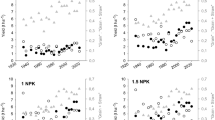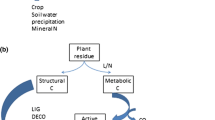Abstract
Modelling of the carbon dynamics in arable soils is complex and the accuracy of the predictions is unknown before the model is applied to each specific site. Objectives were (i) to test the accuracy of predictions of the carbon dynamics using the Rothamsted Carbon (RothC) Model in a field trial in Quzhou, North China Plain, using different methods for initialization and estimation of carbon input into the soil and (ii) to test the applicability of the RothC model for plots with either conventional tillage (CT) or no-tillage (NT) systems. A field trial was conducted with applications of differing amounts of N (0, 112 or 187 kg N ha−1 year−1), P (0, 75 or 150 kg P2O5 ha−1 year−1) and wheat straw (0, 2.25 or 4.5 t DM ha−1 year−1) in differing combinations with either CT or NT for 18 years. CT and NT affected stocks of soil organic carbon (SOC) similarly. Carbon inputs from crops were either estimated from published regression functions that relate C inputs to crop yield including rhizodeposition (models 1 and 2) or published root:aboveground biomass ratios (model 3). Model 1, which was not calibrated to the site conditions, was successful in predicting the carbon dynamics in seven out of nine treatments (model efficiencies EF ranged from 0.28 to 0.87), whereas for two treatments, EF (−0.35 and−2.3) indicated an unsuccessful prediction. The prediction of the C dynamics in NT experiments using model 1 was generally successful, but this may have been due to the fact that NT did not have a specific effect on SOC stocks for this trial. Model 2, which was the same as model 1 except for an optimization of the stock of inert organic matter using one treatment, predicted SOC stocks in the remaining eight treatments overall better than model 1. Model 3 was less successful than models 1 and 2 in all treatments (−19 ≤ EF ≤ 0.56). The results indicate that the RothC model may successfully predict C dynamics—for the site studied even without prior calibration as in model 1—, but care should be taken in choosing an appropriate approach for estimating C inputs into the soil.


Similar content being viewed by others
References
Addiscott TM (1993) Simulation modelling and soil behaviour. Geoderma 60:15–40
Ahl C, Joergensen RG, Kandeler E, Meyer B, Woehler V (1998) Microbial biomass and activity in silt and sand loams after long-term shallow tillage in central Germany. Soil Till Res 49:93–104
Alvarez R (2005) A review of nitrogen fertilizer and conservation tillage effects on soil organic carbon storage. Soil Use Manage 21:38–52
Balesdent J (1996) The significance of organic separates to carbon dynamics and its modelling in some cultivated soils. Eur J Soil Sci 47:485–493
Balesdent J, Balabane M (1992) Maize root-derived soil organic carbon estimated by natural 13C abundance. Soil Biol Biochem 24:97–101
Bao SD (2000) Soil agricultural chemical analysis. Chinese Agricultural Press, Beijing
Bauer J, Herbst M, Huisman JA, Weihermüller L, Vereecken H (2008) Sensitivity of simulated soil heterotrophic respiration to temperature and moisture reduction functions. Geoderma 145:17–27
Bellamy PH, Loveland PJ, Bradley RI, Lark RM, Kirk GJD (2005) Carbon losses from all soils across England and Wales 1978–2003. Nature 437:245–248
Bruun S, Jensen LS (2002) Initialisation of the soil organic matter pools of the Daisy model. Ecol Model 153:291–295
Coleman K, Jenkinson DS (1999) ROTHC-26.3. A model for the turnover of carbon in soil. Model description and windows users’ guide. lawes agricultural trust, Harpenden
Dendoncker N, van Wesemael B, Smith P, Lettens S, Roelandt C, Rounsevell M (2008) Assessing scale effects on modelled soil organic carbon contents as a result of land use change in Belgium. Soil Use Manage 24:8–18
Falloon PD, Smith P (2000) Modelling refractory soil organic matter. Biol Fertil Soils 30:388–398
Falloon P, Smith P, Coleman K, Marshall S (1998) Estimating the size of the inert organic matter pool from total soil organic carbon content for use in the Rothamsted carbon model. Soil Biol Biochem 30:1207–1211
Falloon P, Jones CD, Cerri CE, Al-Adamat R, Kamoni P, Bhattacharyya T, Easter M, Paustian K, Killian K, Coleman K, Milne E (2007) Climate change and its impact on soil and vegetation carbon storage in Kenya, Jordan, India and Brazil. Agric Ecosyst Environ 122:114–124
Franko U (1997) Modellierung des Umsatzes der organischen Bodensubstanz. Arch Acker- Pfl Boden 41:527–547
Franko U, Crocker GJ, Grace PR, Klir J, Körschens M, Poulton PR, Richter DD (1997) Simulating trends in soil organic carbon in long-term experiments using the CANDY model. Geoderma 81:109–120
Gabrielle B, Mary B, Roche R, Smith P, Gosse G (2002) Simulation of carbon and nitrogen dynamics in arable soils: a comparison of approaches. Eur J Agron 18:107–120
Gee GW, Bauder JW (1986) Particle-size analysis, pp 383-409. In: Klute A et al. (ed) Methods of soil analysis. Part 1. 2nd ed. SSSA Book series 5. SSSA, Madison, WI
Guo L, Falloon P, Coleman K, Zhou B, Li Y, Lin E, Zhang F (2007) Application of the RothC model to the results of long-term experiments on typical upland soils in northern China. Soil Use Manage 23:63–70
Helfrich M, Flessa H, Mikutta R, Dreves A, Ludwig B (2007) Comparison of chemical fractionation methods for isolating stable soil organic carbon pools. Eur J Soil Sci 58:1316–1329
Herbst M, Hellebrand HJ, Bauer J, Huisman JA, Simunek J, Weihermüller L, Graf A, Vanderborght J, Vereecken H (2008) Multiyear heterotrophic soil respiration: evaluation of a coupled CO2 transport and carbon turnover model. Ecol Model 214:271–283
Jacobs A, Rauber R, Ludwig B (2009) Impact of reduced tillage on carbon and nitrogen storage of two Haplic Luvisols after 40 years. Soil Till Res 102:158–164
Jenkinson DS, Rayner JH (1977) The turnover of soil organic matter in some of the Rothamsted classical experiments. Soil Sci 123:298–305
Khan SA, Mulvaney RL, Ellsworth TR, Boast CW (2007) The myth of nitrogen fertilization for soil carbon sequestration. J Environ Qual 36:1821–1832
Kushwaha CP, Tripathi SK, Singh KP (2001) Soil organic matter and water-stable aggregates under different tillage and residue conditions in a tropical dryland agroecosystem. Appl Soil Ecol 16:229–241
Leifeld J, Reiser R, Oberholzer HR (2009) Consequences of conventional versus organic farming on soil carbon: results from a 27-year field experiment. Agron J 101:1204–1218
Liu GS (1996) Physical and chemical analysis of soils and profile description. China Standard Publishing House, Beijing, p 266
Liu DL, Cha KY, Conyers MK (2009) Simulation of soil organic carbon under different tillage and stubble management practices using the Rothamsted carbon model. Soil Till Res 104:65–73
Lobe I, Bol R, Ludwig B, Du Preeze CC, Amelung W (2005) Savanna-derived organic matter remaining in arable soils of the South African Highveld long-term mixed cropping: evidence from 13C and 15 N natural abundance. Soil Biol Biochem 37:1898–1909
Ludwig B, Helfrich M, Flessa H (2005) Modelling the long-term stabilization of carbon from maize in a silty soil. Plant Soil 278:315–325
Ludwig B, Schulz E, Merbach I, Rethemeyer J, Flessa H (2007) Predictive modelling of the C dynamics for eight variants of the long-term static fertilization experiment in Bad Lauchstädt using the Rothamsted Carbon Model. Eur J Soil Sci 58:1155–1163
Ludwig B, Kuka K, Franko U, von Lützow M (2008) Comparison of two quantitative soil organic carbon models with a conceptual model using data from an agricultural long term experiments. J Plant Nutr Soil Sci 171:83–90
Malamoud K, McBratney AB, Minasny B, Field DJ (2009) Modelling how carbon affects soil structure. Geoderma 149:19–26
Michel K, Ludwig B (2009) Prediction of model pools for a long-term experiment using near-infrared spectroscopy. J Plant Nutr Soil Sci. doi:10.1002/jpln.200800181
Müller MJ (1982) Selected climatic data for a global set of standard stations for vegetation science. Dr. W. Junk, The Hague
Paustian K, Six J, Elliott ET, Hunt HW (2000) Management options for reducing CO2 emissions from agricultural soils. Biogeochemistry 48:147–163
Puhlmann M, Kuka K, Franko U (2006) Comparison of methods for the estimation of inert carbon suitable for initialisation of the CANDY model. Nutr Cycl Agroecosys 74:295–304
Rethemeyer J, Grootes PM, Brodowski S, Ludwig B (2007) Evaluation of soil 14C data for estimating inert organic matter in the RothC model. Radiocarbon 49:1079–1091
Shi YC, Li YZ, Lu JW (1986) Water and salt movement in salt-affected soil. Beijing Agricultural University Press, Beijing (In Chinese)
Skjemstad JO, Spouncer LR, Cowie B, Swift RS (2004) Calibration of the Rothamsted organic carbon turnover model (RothC ver. 26.3) using measurable soil organic carbon pools. Aust J Soil Res 42:79–88
Smith P, Smith JU, Powlson DS, McGill WB, Arah JRM, Chertov OG, Coleman K, Franko U, Frolking S, Jenkinson DS, Jensen LS, Kelly RH, Klein-Gunnewiek H, Komarov AS, Li C, Molina JAE, Mueller T, Parton WJ, Thornley JHM, Whitmore AP (1997) A comparison of the performance of nine soil organic matter models using datasets from seven long-term experiments. Geoderma 81:153–225
Tang HJ, Qiu JJ, Van Ranst E, Li CS (2006) Estimations of soil organic carbon storage in cropland of China based on DNDC model. Geoderma 134:200–206
Thomsen IK, Bruun S, Jensen LS, Christensen BT (2009) Assessing soil carbon lability by near infrared spectroscopy and NaOCl oxidation. Soil Biol Biochem 41:2170–2177
Yang XM, Zhang XP, Fang HJ, Zhu P, Ren J, Wang LC (2003) Long-term effects of fertilization on soil organic carbon changes in continuous corn of northeast China: RothC model Simulations. Environ Manage 32:459–465
Zhang XR, Li HW, He J, Wang QJ, Golabi MH (2009) Influence of conservation tillage practices on soil properties and crop yields for maize and wheat cultivation in Beijing, China. Aust J Soil Res 47:362–371
Zimmermann M, Leifeld J, Schmidt MWI, Smith P, Fuhrer J (2007) Measured soil organic matter fractions can be related to pools in the RothC model. Eur J Soil Sci 58:658–667
Acknowledgements
This cooperation was initiated by an excursion funded by the Deutsche Forschungsgemeinschaft (Research Training Group 1397). K. Hu received grants from the National High-Tech Research and Development Program of China (2007AA10Z217). Two anonymous referees have provided valuable comments and suggestions.
Author information
Authors and Affiliations
Corresponding author
Additional information
Responsible Editor: Ingrid Koegel-Knabner.
An erratum to this article can be found at http://dx.doi.org/10.1007/s11104-012-1189-4
Rights and permissions
About this article
Cite this article
Ludwig, B., Hu, K., Niu, L. et al. Modelling the dynamics of organic carbon in fertilization and tillage experiments in the North China Plain using the Rothamsted Carbon Model—initialization and calculation of C inputs. Plant Soil 332, 193–206 (2010). https://doi.org/10.1007/s11104-010-0285-6
Received:
Accepted:
Published:
Issue Date:
DOI: https://doi.org/10.1007/s11104-010-0285-6




